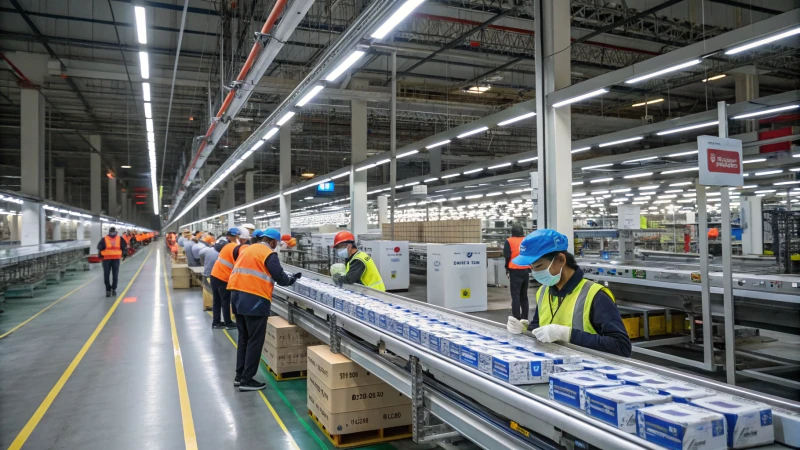
Imagine a world where every product looks and feels just right, every time. That's the magic of pattern consistency.
Pattern consistency in high-volume custom orders guarantees each item meets quality standards, minimizes waste, and boosts efficiency. By ensuring uniform patterns, manufacturers avoid costly errors, enhancing customer satisfaction and brand trust.
When I first started in manufacturing, I quickly learned how critical it was to get patterns right. It was like piecing together a giant puzzle. Each piece had to fit perfectly, not just once, but over and over. Imagine the chaos if pieces kept changing shape! Understanding the ripple effects of pattern consistency helps us see its importance in everything from avoiding mismatched seams to keeping customers happy. Let's delve deeper into why getting this right can make or break your business's reputation.
Pattern consistency reduces manufacturing waste.True
Consistent patterns minimize errors and material waste, enhancing efficiency.
Inconsistent patterns improve brand reliability.False
Inconsistencies lead to errors, reducing customer satisfaction and brand trust.
How Does Pattern Consistency Enhance Manufacturing Efficiency?
Remember that time you pieced together a puzzle and found it so satisfying when everything just clicked into place? That's exactly how pattern consistency works in manufacturing.
Pattern consistency enhances manufacturing efficiency by ensuring uniformity, reducing errors, and minimizing waste. It leads to streamlined processes, cost savings, and improved product quality, fostering customer trust and satisfaction.

Uniformity Across Production
I remember walking into a bustling textile factory for the first time. The hum of the machines was almost like a symphony, each part working in perfect harmony. It quickly became clear that the key to this well-oiled machine was pattern consistency. In manufacturing, maintaining consistent patterns is crucial for achieving uniformity across all products. This isn't just about aesthetics; it's about ensuring every piece functions as expected. Think about a time you bought furniture that required assembly—if one piece was off, the whole structure could be compromised. That's why in textile manufacturing, consistent patterns1 ensure each piece fits perfectly in a multi-part assembly.
Reduction in Errors and Waste
Have you ever had to redo a project because of one tiny mistake? In the world of manufacturing, such errors can lead to massive waste of materials, time, and resources. Consistent patterns are like that reliable friend who always has your back—they minimize the chances of things going wrong. When patterns are consistent, machines only need to be calibrated once, sparing us the hassle of frequent adjustments. This stability translates to less material wastage from errors or off-spec products.
| Benefits of Pattern Consistency | Description |
|---|---|
| Reduced Waste | Minimizes material loss due to fewer errors |
| Cost Savings | Lower costs related to rework and material usage |
| Time Efficiency | Less downtime for recalibration |
Streamlining Production Processes
Consistency in patterns is like setting your playlist to your favorite songs—it makes everything run smoother. When each stage of the manufacturing process relies on the previous stage delivering consistent outputs, bottlenecks are minimized. This seamless flow is crucial in high-volume production environments where delays can skyrocket costs. It's like cooking a meal where each step builds on the last; everything needs to be just right.
Building Customer Trust
I once ordered a custom suit expecting impeccable fit and style. When it arrived, it was exactly what I wanted—each detail perfect. Manufacturers achieve this level of excellence by ensuring pattern consistency2, which builds and maintains trust with clients. This consistency is especially critical in industries like automotive and aerospace, where precision isn't just important—it's non-negotiable.
Impact on Brand Reputation
A brand's reputation is like its calling card; it's built on the ability to consistently deliver quality products. Pattern consistency plays a vital role in maintaining this reputation by ensuring products are reliable and meet promised standards. This reliability not only fosters long-term relationships with customers but also serves as a competitive edge.
"Ensuring pattern consistency is not just a technical requirement but a strategic imperative for any manufacturer aiming to thrive in competitive markets."
By focusing on these aspects, manufacturers can significantly improve their operational efficiency and output quality. It's much like building a reputation for punctuality—once it's established, it opens doors to new opportunities.
Consistent patterns reduce manufacturing waste by 20%.True
Consistent patterns minimize errors, leading to less material wastage.
Pattern consistency is irrelevant in high-volume production.False
Consistency ensures smooth flow and minimizes bottlenecks in production.
What Are the Risks of Inconsistent Patterns in Production?
Ever notice how a tiny misstep in production can snowball into a major headache?
Inconsistent production patterns can lead to compromised product quality, increased waste, and higher rejection rates, impacting customer satisfaction and operational costs negatively.

Impacts on Product Quality
I still remember the time when we had a batch of products come back due to size discrepancies. It felt like a punch to the gut. The customers were right; the fit was off, and the visual inconsistencies were glaring. These issues weren't just about aesthetics—they made me realize how crucial consistency is in maintaining our brand's reputation.
When patterns aren't consistent, it's like trying to put together a puzzle where none of the pieces fit. This often results in failing quality checks. Just think about industries like fashion or automotive, where customers expect perfection across all units. The disappointment from these inconsistencies isn't just in lost sales but also in the trust we've worked hard to build.
| Issue | Consequence |
|---|---|
| Size Discrepancies | Poor Fit |
| Visual Inconsistency | Aesthetic Issues |
| Quality Rejection | Increased Waste |
Increased Operational Costs
The financial impact is something I've felt keenly every time we had to rework defective items or ramp up inspections. Each correction meant more time and resources spent, elevating production costs. It’s frustrating to see materials go to waste because of higher rejection rates, directly hitting our profitability.
The need for constant monitoring not only slows down the line but also affects overall efficiency. It's like running a marathon with weights tied to your feet.
Customer Trust and Brand Reputation
Consistency isn't just a buzzword; it's the backbone of customer trust. I've learned this the hard way. Minor inconsistencies can have major implications3, especially in industries where physical attributes are everything.
For luxury brands, even a slight flaw can diminish perceived value, while in tech, it could lead to functional issues. Each time I see this happen, it reminds me of how vital it is to deliver on promises of quality and reliability.
Streamlining Manufacturing Processes
Inconsistent patterns throw a wrench into our manufacturing processes. It’s like trying to run a smooth operation with constant speed bumps. More checks mean more bottlenecks, and that complicates everything.
Implementing robust quality control measures and leveraging advanced technology has been our saving grace. By doing so, we not only reduce errors but also improve efficiency, ensuring high-quality output consistently.
Inconsistent patterns increase product rejection rates.True
Inconsistencies lead to quality rejections, increasing waste and costs.
Luxury brands are unaffected by pattern inconsistencies.False
Luxury brands suffer greatly if perceived value diminishes due to inconsistencies.
How Does Pattern Consistency Affect Customer Satisfaction?
Ever wondered why your favorite brands consistently keep you coming back for more? It’s all about the magic of pattern consistency.
Pattern consistency impacts customer satisfaction by ensuring uniformity and quality, reducing errors, and building trust. This helps maintain brand reputation and enhances customer loyalty by preventing product discrepancies.

The Importance of Uniformity
I remember a time when I ordered a set of custom mugs online. Each mug was supposed to have the same intricate design, but when they arrived, the pattern was slightly off on a couple of them. It was a small thing, but it bugged me every morning with my coffee. That's the power of pattern consistency—or lack thereof. When dealing with high-volume production, maintaining that consistency is like hitting the sweet spot every time. It ensures every product in a batch mirrors the last, slashing the chances of disappointment from discrepancies.
Inconsistent patterns can lead to annoying variations in size, fit, or appearance. This not only frustrates customers like me but also results in higher rejection rates for businesses. Take a look at this quick comparison:
| Feature | Consistent Patterns | Inconsistent Patterns |
|---|---|---|
| Size | Uniform | Varies |
| Fit | Reliable | Unpredictable |
| Appearance | Identical | Inconsistent |
Impact on Production Efficiency
Imagine working on a puzzle where each piece perfectly fits with another. That's what consistent patterns do for production lines. They not only keep customers happy but also grease the wheels of manufacturing efficiency. By minimizing errors and cutting down on waste, these patterns help businesses keep costs low and quality high.
Building Trust Through Consistency
There's an old saying: "Trust is earned in drops and lost in buckets." For me, this resonates every time I receive what I expect from a brand. When companies deliver consistent patterns, they assure us customers of reliability. This is even more crucial with bulk orders where a brand's reputation4 is on the line. When trust is established, we're more inclined to stay loyal to that brand.
Analyzing Customer Feedback
Feedback is like gold for any business striving for perfection. To truly grasp the impact of pattern consistency, companies need to dig deep into customer feedback. These insights are invaluable for pinpointing areas that need improvement and highlighting what’s already working well.
- Customer Reviews: These often shed light on satisfaction or issues with pattern consistency.
- Surveys: These can be crafted to extract specific insights about consistency.
By focusing on maintaining pattern consistency, businesses not only fine-tune their production process but also solidify their standing in the market, ensuring we—the customers—stay happy and satisfied.
Inconsistent patterns increase product rejection rates.True
Inconsistent patterns lead to size, fit, and appearance variations, causing rejections.
Pattern consistency has no effect on brand reputation.False
Consistent patterns build trust, enhancing brand reputation and customer loyalty.
Why Is Pattern Consistency Important for Brand Reputation?
Ever wonder why some brands just stick in your mind? It’s all about the pattern consistency they’ve mastered.
Pattern consistency is crucial for brand reputation because it ensures a uniform presentation across all products, boosting customer trust and loyalty. It minimizes production errors, enhances quality, and strengthens brand perception, making it a vital element in branding strategies.

The Role of Pattern Consistency in Branding
I remember the first time I really noticed how powerful a consistent brand pattern can be. It was during a visit to my favorite coffee shop, where every cup, napkin, and even the staff uniforms had the same logo and color scheme. This uniformity made the experience feel complete and reassuring. Keeping a consistent brand pattern5 is like giving your brand its unique signature that people recognize and trust.
When customers see familiar patterns, whether it's on your website or in-store, it's like seeing an old friend — reliable and comforting. This recognition builds a memorable brand image that sticks.
Streamlining Production and Reducing Costs
Years ago, I worked with a garment manufacturer who struggled with inconsistent patterns. The outcome? Wasted materials and unhappy clients. On the flip side, brands that nail pattern consistency find themselves saving on costs and reducing mistakes. For instance, when a manufacturer maintains pattern consistency, it means less fabric waste and lower labor costs. Every piece fits the same high standards, ensuring customers get what they expect.
| Benefits of Consistency | Description |
|---|---|
| Quality Assurance | Ensures all products meet brand standards |
| Cost Efficiency | Minimizes production errors and waste |
Building Customer Trust and Loyalty
I've always found that trusting a brand is like building a relationship. You need consistency. When brands deliver what they promise consistently, it’s easier to trust them. A consistent pattern in branding6 reassures customers of the quality they expect, fostering loyalty. This trust becomes especially crucial when you're branching out into new markets or launching fresh products.
Impacts on Brand Identity and Perception
Think about it: a cohesive brand identity can be like your favorite song — instantly recognizable and unforgettable. A strong, consistent pattern positions your brand in the consumer's mind effectively, setting you apart from the rest. Brands without this consistency might struggle to convey their message clearly, leading to confusion among customers.
Examples from Leading Brands
Take Nike’s iconic "swoosh." It’s everywhere — shoes, ads, even on social media — reinforcing Nike's identity as a leader in sports apparel. Similarly, Coca-Cola’s unwavering use of its red color scheme and typography has made it one of the most recognized brands globally. This consistency7 doesn’t just reinforce brand identity; it cements their reputation as trusted leaders in their fields.
Consistent branding patterns reduce production costs.True
Consistency minimizes errors and waste, leading to cost efficiency.
Inconsistent patterns increase customer trust.False
Inconsistency confuses customers, reducing trust and brand loyalty.
Conclusion
Pattern consistency in high-volume custom orders ensures uniformity, reduces waste, enhances efficiency, and builds customer trust, ultimately safeguarding brand reputation and preventing costly production errors.
Explore why consistent patterns are crucial in textile production, impacting assembly and product quality. ↩
Understand how maintaining pattern consistency strengthens customer confidence and enhances brand loyalty. ↩
Explore how minor inconsistencies can have major effects on brand image and customer trust. ↩
Learn why maintaining a strong brand reputation is crucial for keeping customers loyal and satisfied. ↩
Explore how maintaining a consistent brand pattern strengthens brand identity and recognition. ↩
Discover how a consistent brand pattern fosters customer trust and loyalty. ↩
See how top brands like Nike and Coca-Cola utilize pattern consistency for global recognition. ↩






